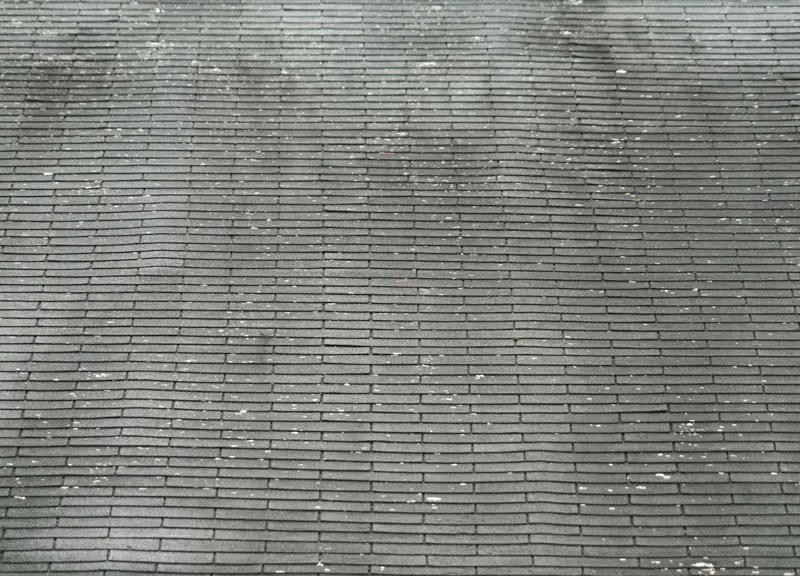Replacing your roof is never fun, but most homeowners will have to do it at some point if they own their home long enough. In this guide, discover 10 signs that you need a new roof and learn why keeping it in good condition is so important.
Why Replacing a Roof is Important
Replacing your roof is one of the most expensive home improvement projects, but it’s important for several reasons. You can avoid serious damage and prevent a wide range of issues by replacing your roof promptly.
Preventing Structural Damage
Leaking and sagging roofs can cause structural damage to the rest of your home, leading to higher repair costs. When your roof starts to deteriorate, it can lead to many other issues, potentially damaging the plywood sheathing underneath the roofing material.
Old roofs can also lead to problems that deteriorate the fascia and soffit materials, allowing moisture, insects, and pests to access your home’s eaves and attic spaces.
Enhancing Property Value
You’re not likely to see a 100% return on your investment when you install a new roof, but it will still add significantly to your property’s value. If you’re looking to sell, replacing your roof can make it easier to sell your home because the condition of a roof can affect whether some buyers can get financing.
Avoiding Accidents and Injuries
If a roof goes long enough without proper maintenance, it will eventually collapse. Fortunately, there are a lot of warning signs before that happens, but deteriorating roofs can still be a safety hazard. If your roof is sagging, it could be unsafe to walk on, so use caution to avoid accidents and injuries.
Preventing Leaks and Water Damage

Roofs naturally become more susceptible to leaks and water damage the older they get. Normal wear and tear from wind, rain, cold, and heat will cause roofing materials and fasteners to loosen and shift over time. Once water seeps into the structure, it will contribute to other issues, like decay, mold, and mildew.
Improved Insulation
If you’ve recently conducted an energy audit for your home, you might have realized that your roof allows a lot of heat to escape. Some roofing materials, like tiles and asphalt shingles, have better insulating value than other types of roofing.
When replacing your roof, it’s an excellent time to invest in modern insulation materials and ventilation systems that will improve your home’s energy efficiency.
Your attic is one of the most important places to insulate, especially considering that it’s right under your roof. Find out how much insulation you’ll need to do the job.
Lower Energy Bills
You can also lower your air conditioning costs by choosing materials that reflect heat during the summer. Consider metal, clay, or slate tiles to lower your energy bills if you live in a hot climate. Terra-cotta is popular in the Southwest because it can withstand the heat.
Color is another critical factor when selecting cool roofing materials. A light color will reflect more heat than a dark color.
10 Signs That You Need a New Roof
It’s not always easy to tell when your roof needs to be replaced. Learn how to tell if your roof needs replacing with these 10 signs you need a new roof.
Age of the Roof
The average lifespan of a roof is about 25 to 50 years, but the actual life expectancy of your roof depends on a few factors, including the quality and type of materials and the quality of the installation. Your climate can also impact how long your roof lasts.
Here are some common roof types and their typical life expectancies:
| Roof material | Expected lifespan in years |
| Three-tab asphalt shingles | 15 to 20 |
| Wood shingles | 25 to 30 |
| Metal | 20 to 50 |
| High-quality asphalt shingles | 30 to 50 |
| Composite shingles | 40 to 50 |
| Clay (terra-cotta) tiles | 50 to 100 |
| Concrete tiles | 50 to 100 |
| Slate tiles | 50 to 200 |
Water Leaks
Leaks can happen for various reasons, no matter how old or new your roof is. However, old roofs are more likely to be leaky and are a sure sign that your roof is bad. Look for signs of water damage, such as stains on the walls or ceiling, and mold or mildew in your attic to determine if it’s time to replace your roof.
Damaged or Missing Shingles
The climate takes a toll on your roof. Excess heat, extreme weather events, and ice dams can damage the shingles, and if your roof is older, you may notice damaged or missing shingles. A roof inspection will help inform you when to replace shingles.
Algae or Moss Growth

One of the most common signs your roof needs to be replaced is the growth of moss and algae. Over time, debris and water collect on your roof and contribute to moss and algae growth, which can eat away at the protective layer on your roofing materials.
Moss and algae are more than an aesthetic issue for homeowners. They can be a sign of more serious problems, such as decaying or deteriorating roofing materials.
Granule Loss
The protective granules on asphalt shingles will eventually start to loosen and erode, washing away after years of wind, hail, rain, and snow. You may not even have to get on your roof to determine if your shingles show signs of granular loss. Walk around the perimeter of your home or look for granules where your gutter system deposits water from your roof.
Sagging or Drooping Roof
A sagging or drooping roof deck is one of the most dreaded warning signs you need a new roof. This problem usually indicates structural issues that should be addressed immediately to prevent further damage.
Increased Energy Bills
Your roof is one of the primary components of your home’s ventilation system. If you notice a sudden increase in your energy bills, it could be due to a problem with your roof. Damaged roofs allow air to leak out of your home, making it harder to heat or cool, depending on the season.
Light in the Attic
If you’re wondering when to get a new roof, seeing daylight coming in can eliminate all doubts. Seeing light in your attic indicates a more significant concern than a missing or damaged shingle. Unfortunately, you’re likely to notice other signs, like water damage and heat loss, indicating it’s time to get a new roof.
Visible Damage Around Roof Features

Some visible signs of damage around certain roof features can indicate that it’s time to replace your roof. Old flashing materials can appear curled, damaged, or rusted and may be missing altogether. Loose flanges or seals on skylights and vents indicate it’s time for roof replacement.
Roofing Material Issues
Various roofing materials will show signs that your roof needs replacing in slightly different ways. Metal roofing will appear faded, discolored, or wrinkled. Various types of tiles, such as slate, clay, or concrete, may be cracked, broken, discolored, or delaminated. With old wood shingles that have become soft and porous, even if you clean them, algae and moss will grow right back.
Replacing a roof is often your only option, but you can lengthen the life of your existing roof if you take care of it. Here are some roof maintenance tips to get you started!
Tips for Replacing a Roof
Replacing a roof is a significant investment. You must make wise financial decisions about your roof to protect your investment in your home. Follow these tips to save money on roof replacement and ensure you’re making the right decisions.
Ensure You Assess the Need for Replacement
If you’re not sure whether you need a new roof, a roof inspection is the best way to assess your roof. Periodic roof inspections will help ensure that your roof is sound and help you make informed decisions about replacement.
Make a Confident Choice of Roofing Material
You can choose from many types of roofing materials. Making a confident decision about the best type of roof for your home should involve consideration of the following factors:
- Durability
- Roof pitch
- Climate
- Maintenance
- Material and labor costs
- Energy efficiency
- Aesthetics
- Warranty
Choose a Trustworthy Roofing Contractor

Roof replacements and repairs aren’t DIY-friendly, which leaves most people with the tough decision of finding the right roofing contractor. Whenever you hire a professional, it pays to do your research. Ask lots of questions, obtain and check references, and get at least three quotes from reputable roofers in your area.
Prepare Your Space for a Smooth Roof Replacement
You may be able to save some money by doing some of the preparation work yourself. Replacing a roof can be messy, but it helps to clear the area around your home before the work starts. Mow the grass short to make cleanup easier, and protect bushes and hardscaping features by covering them with tarps.
Execute a Seamless Roof Replacement Process

Delays in recognizing signs that you need a new roof are costly in any construction project, but with roof replacement, they can spell disaster, especially if you run into bad weather. Proper planning will ensure a trouble-free roof replacement. Ensure everything is in order by obtaining permits, having a detailed contract, and maintaining communication with your roofing contractor.
Ensure the Longevity of Your Roof with Post-Installation Inspections and Maintenance
Before hiring a roofing contractor, make sure the warranty on materials and labor is written into the contract. Your contract should also include at least one post-installation inspection. You can inquire about additional maintenance services to ensure the longevity and performance of your new roof.
Plan Your Roof Replacement Budget with Confidence
When budgeting for a roof replacement, stay confident. If you research all of your options for various materials and choose the right contractor, you’ll make good decisions that will save you money in the long run.



